Did you know that by 2027, 62% of global online shopping is expected to happen on online marketplace websites? What’s even more interesting is that 48% of ecommerce customers go directly to a multi vendor portal when shopping online.
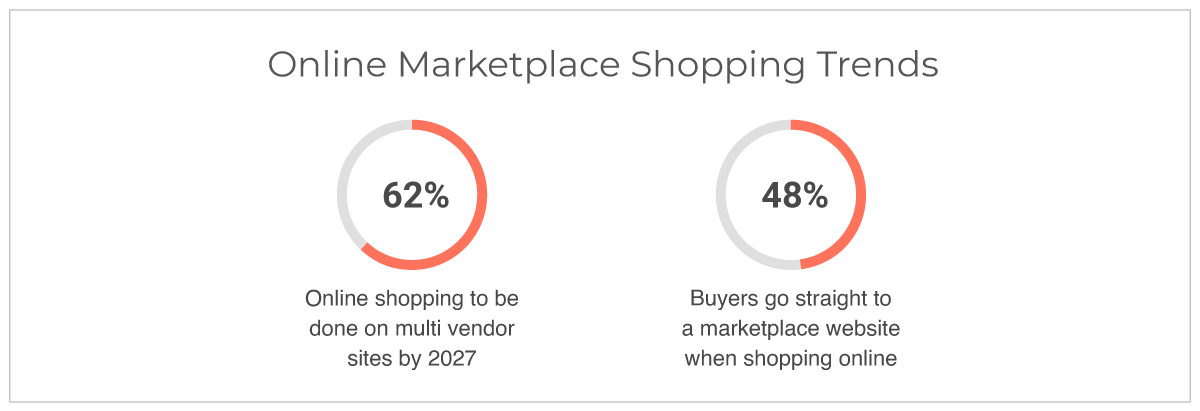
Source: Statista
Interesting figures indeed! More than just being stats, these numbers clearly reflect how buyer behaviour is shifting.
Online shoppers want variety, convenience and the trust that comes with established platforms. And with the rise of AI powered ecommerce, online marketplaces are getting even smarter, offering personalized experiences, intelligent recommendations, and faster fulfillment.
No wonder global giants like Amazon, Alibaba, and eBay continue to dominate. They have mastered what today’s customers expect: an effortless, AI-driven, multi seller shopping experience that delivers value at every step.
The message is clear: marketplace commerce, supercharged by AI, is where the future lies. And forward-looking enterprise brands are already making their move.
Table of Contents
- Why This is the Right Time for Enterprise Brands to Build a Marketplace Website
- How to Build a marketplace Website for the AI Era in 2025 and Beyond
- 10-Step Process to Build a Marketplace Website for the AI Era
- 1. Outline your Online Marketplace Business Idea and Model
- 2. Validate Your Marketplace Vision and Define Business Needs
- 3. Choose The Right Marketplace Platform
- 4. Set Up Marketplace Domain and Identity
- 5. Design an Engaging Marketplace Website
- 6. Set Up Mobile Commerce Sales Channels
- 7. Onboard Vendors and Get Products Listed
- 8. Add Payment and Logistics to Power Seamless Fulfilment
- 9. Set Up Marketing and Promotion to Drive Growth
- 10. Test Your Marketplace Site and Go Live
- Conclusion
- FAQs
Why This is the Right Time for Enterprise Brands to Build a Marketplace Website
The most successful ecommerce brands aren’t just following the marketplace trend, they are using the model to disrupt the market. From B2B to D2C to hybrid B2B2C marketplace models and everything in between, enterprises are building multi seller set ups that align closely with what their customers actually want.
Wonder what’s driving these new-age marketplaces at a speed like never before? AI powered ecommerce, by simplifying and speeding up businesses process and making ecommerce more intuitive, and built for the way people shop now.
Here is what industry insights tell us about the omnipresent online marketplace model:
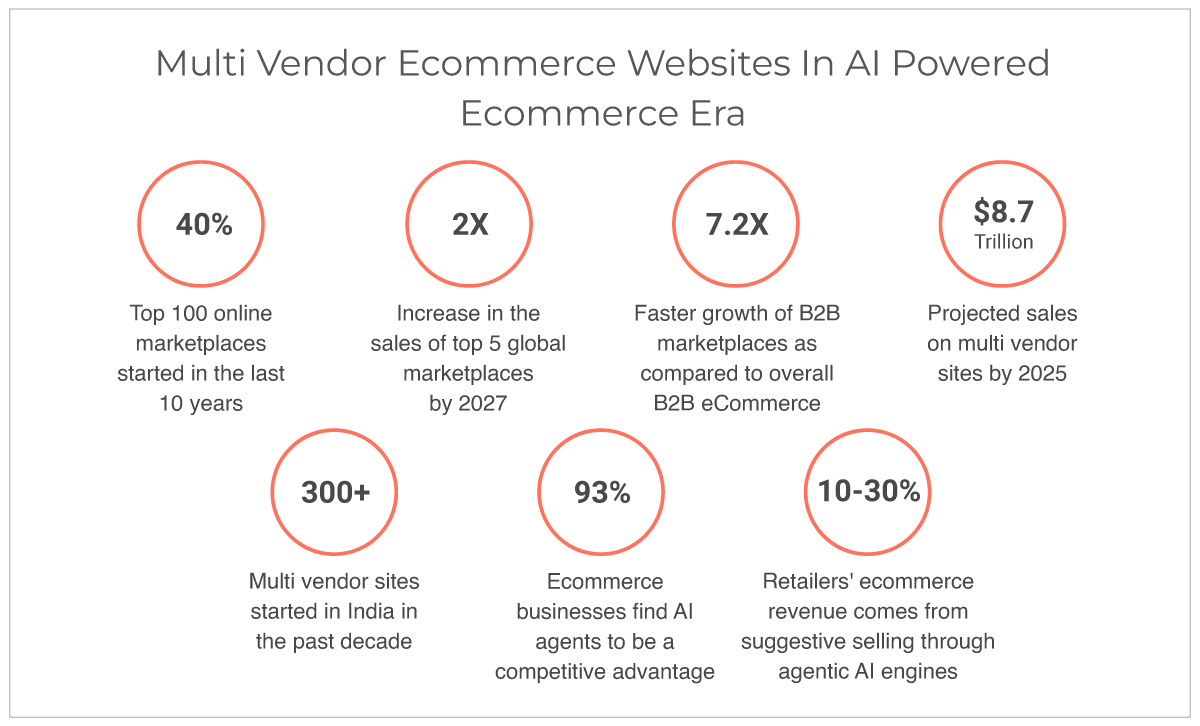
- 40% of top 100 online marketplaces started in the last 10 years
- 2X increase in the sales of top 5 global marketplaces by 2027
- 7.2X faster growth of B2B marketplaces as compared to overall B2B eCommerce
- $8.7 trillion is the projected sales on multi vendor sites by 2025
- 300+ multi vendor sites started in India in the past decade
- 93% of ecommerce businesses find AI agents to be a competitive advantage
- 10%-30% of retailers' ecommerce revenue comes from suggestive selling through agentic AI engines
Source: Statista, Digital Commerce 360, McKinsey Global Survey, Number Analytics, Barilliance survey
Well, it’s more than evident why enterprise ecommerce players are keen to build a marketplace website powered by AI. The multi vendor model is proving to be a high-impact strategy across industries, driving revenue, reach, and customer loyalty. And with the added intelligence of AI powered ecommerce, businesses are now better positioned than ever to scale faster, adapt quicker, and deliver truly personalized shopping experiences.
How to Build a marketplace Website for the AI Era in 2025 and Beyond
Surely, building another Amazon is an uphill task. From deciding the business model to choosing the right marketplace software for the AI era and onboarding the vendors can be a long winding road ahead.
The toughest part for most businesses is to find the right multi vendor ecommerce solution with real AI capabilities for their brand. While there are a host of solution providers in the market, not many have the right enterprise grade feature set and built-in AI features to build your online marketplace.
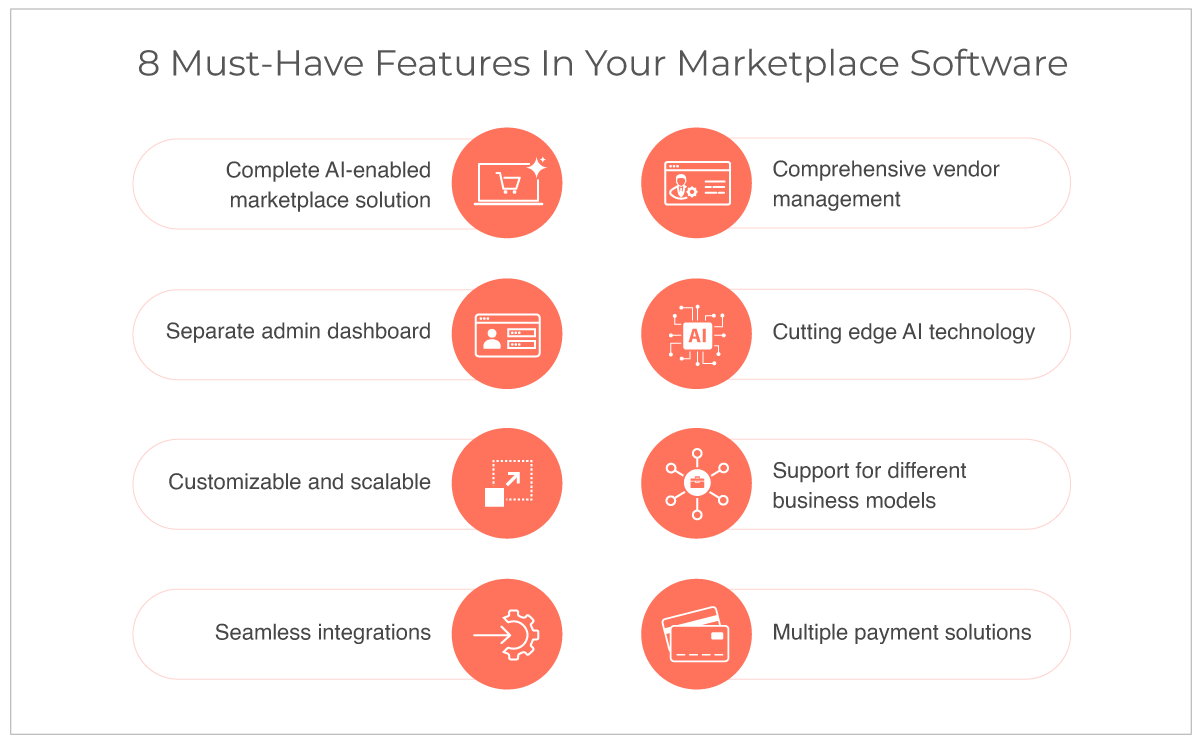
Finding the right marketplace solution is the first step towards ensuring the success of your brand. Here are the top 8 things your marketplace software should have:
- A complete AI-enabled marketplace solution that takes care of every aspect of the business
- Comprehensive vendor management solutions that automate vendor onboarding, commissions, payouts, order management etc.
- Offers a separate admin dashboard to the vendors so they can run and grow their business freely
- Cutting edge AI technology and tools that simplify business processes and help your brand sell more
- Customizable and scalable multi vendor ecommerce website builder that can accommodate market changes and your growing business
- Support for different business models like B2B, D2C, multi store, hyperlocal ecommerce, so you have the freedom to experiment with and pivot to any new business model
- Seamless integrations to help you build your own unique ecommerce environment by adding the best ecommerce software for your business
- Offers multiple payment solutions to make it easy for your customers to buy on your multi vendor ecommerce website
Along with these you marketplace software should also be easy to use for all parties involved and offer transparent pricing so you are clear about the costs involved. Also, check if you are getting post-sales support to handle your queries.
StoreHippo's AI powered multi-vendor ecommerce platform offers all the above features in its fully hosted and managed marketplace solutions. With the experience of building multi vendor marketplaces for domestic and international enterprise brands, StoreHippo makes it easy for you to go to market in record time.
10-Step Process to Build a Marketplace Website for the AI Era
To help you build your dream marketplace, we bring you a step-by-step guide that takes care of everything you need to know - from ideating and creating your multi-seller business to launching and growing it.
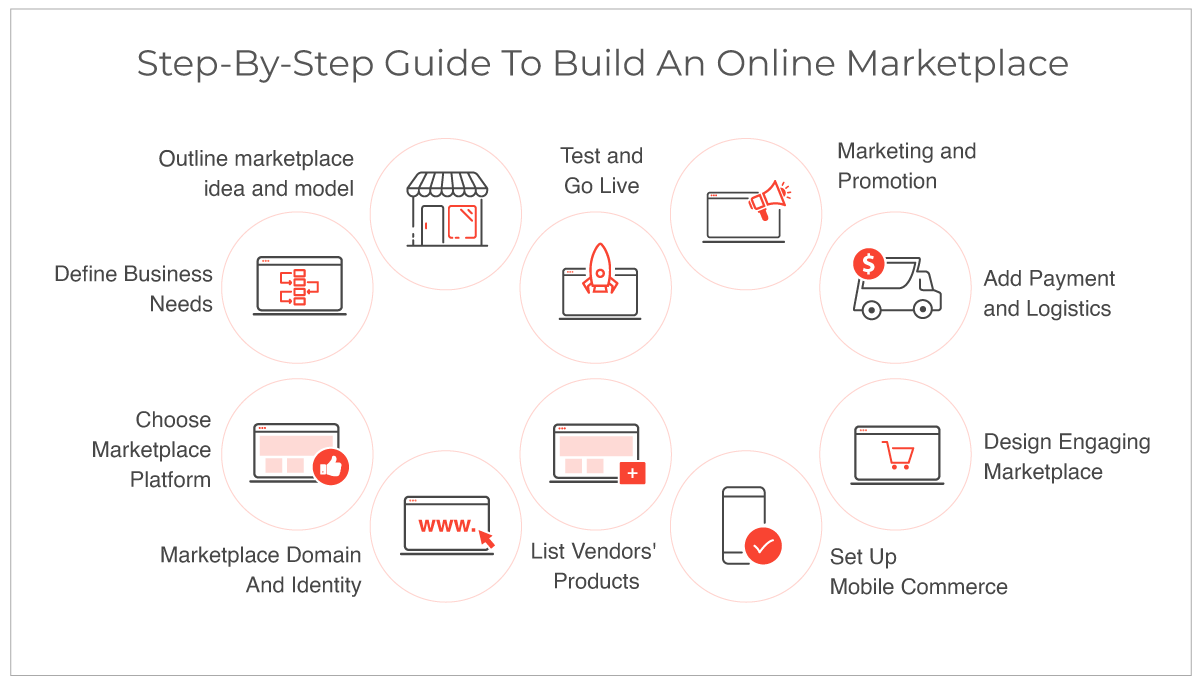
Here we go:
1. Outline your Online Marketplace Business Idea and Model
From electronics and fashion to mobility, wellness services and quick commerce hyperlocal marketplaces, the ecommerce landscape is already populated with a wide range of online marketplaces. As an enterprise brand going online, it's important to identify a focused segment where your brand can add unique value rather than trying to compete broadly from the start.
Even global giants like Amazon began with a vertical model, focusing solely on books, before evolving into a horizontal multi vendor marketplace spanning nearly every category. Similarly, successful digital-first brands like Swiggy. Blinkit, Nykaa etc. have built marketplaces around solving specific customer needs.
For your enterprise, the key is to build a marketplace website that aligns with both your business strengths and current market gaps. Whether product-led or service-focused, your model should be driven by what your audience truly needs and powered by the flexibility to adapt as those needs evolve.
Pro Tip: Research your TAM ( Total Addressable Market) and SAM ( Serviceable Available Market) to make informed decisions and plan strategic growth. Start with a niche that aligns with your core business strengths, and scale horizontally once you've validated demand and built operational maturity.
2. Validate Your Marketplace Vision and Define Business Needs
When your enterprise brand is making its digital foray, validating the marketplace idea goes beyond just identifying demand, it’s about understanding how your value proposition fits into the current digital landscape. Are you planning to launch a niche product marketplace like Nykaa, a service aggregator like Urban Company, or a dealer-led model like Udaan? Each model demands a different mix of features, workflows, and operational depth.
Before diving into execution, take a step back to thoroughly assess your online marketplace proposition. Whether you are entering a new vertical or digitising existing operations, it’s important to research buyer expectations, market dynamics and competitor strategies.
This is the stage to map out what your business will need to succeed, whether it’s bulk order management, vendor-specific pricing, inventory sync across locations, or multilingual support. Doing this groundwork ensures you're not just building a marketplace, but building the right one for your industry and audience.
Pro Tip: Before you build a marketplace website, outline your core workflows and non-negotiable features early. It will make selecting the right AI powered marketplace solution much faster and more aligned to your goals.
3. Choose The Right Marketplace Platform
Once you have validated your marketplace idea and outlined your core business requirements, the next crucial step is selecting the right marketplace builder. Not all platforms are built to support the depth and complexity of enterprise-grade marketplaces.
Think about the differences between a service-based model like Airbnb, where listings, availability, and location-based discovery are critical, and a B2B wholesale model like IndiaMART, which needs bulk order workflows, inquiry management, and RFQs. Your online marketplace platform should be able to support the specific workflows your business demands, whether that’s dynamic pricing, multilingual catalogs, vendor-led fulfillment, or regional stores.
That’s where a future-ready, AI powered ecommerce platform like StoreHippo comes in. With 300+ enterprise features, built-in support for different marketplace models, and headless architecture, it enables businesses to launch fast, integrate smoothly, and evolve without hitting platform limitations.
Pro Tip: Think long-term choose a platform to build your marketplace website that can not only handle your current model but also adapt as your brand scales into new markets, verticals, or service offerings.
4. Set Up Marketplace Domain and Identity
Before you build a marketplace website, you need a strong digital identity that reflects your business vision and builds instant trust with both buyers and vendors. For enterprise brands, this goes beyond just picking a name, it’s about brand positioning. Think of how Amazon Business clearly conveys its B2B marketplace focus, or how Airbnb suggests accessibility and a sense of place, making the platform instantly relatable.
Choose a brand name that’s simple, scalable, and aligned with your vertical, especially if you're planning to expand your multi vendor ecommerce website across geographies or product lines. Once you finalize the name, register a domain with a reliable TLD like .com that gives you global reach. Ensure foundational setups like SSL certification, branded email domains, and verified social handles are in place to create a secure and consistent presence across touchpoints.
This step is crucial because when people search for things like “trusted online marketplaces for [your niche]” or “where can I buy [category] online,” your name and domain need to resonate and rank.
StoreHippo has you covered here. The PCI-DSS and ISO-compliant StoreHippo ecommerce platform offers free SSL for building your marketplace. You also get access to multi level security features like, user based roles, audit logs, data encryption, authentication and authorization, prevention from cross scripting and HTML injection, and more.
Pro Tip: Future-proof your brand, go for a name and domain that allow you to grow beyond your initial niche without needing to rebrand down the line.
5. Design an Engaging Marketplace Website
Design isn’t just about visuals, it’s about building intuitive, engaging experiences across your online marketplace that keep buyers coming back. For enterprise brands, this means creating a design that reflects your brand identity, scales with your business, and adapts to multiple customer journeys.
Take Etsy, for example, the platform’s clean, creative aesthetic reflects its community of independent sellers. Or Myntra, whose vibrant, fashion-forward design caters to its style-conscious audience. Your multi vendor ecommerce website should deliver a similarly cohesive experience across desktop, mobile, and apps especially in a market where first impressions directly impact conversions.
StoreHippo AI powered ecommerce solutions for enterprises simplify marketplace design with built-in drag-and-drop tools, dynamic page creation, customisable themes, and support for multilingual themes, making it easy for enterprises to build a marketplace website that’s both brand-aligned and conversion-friendly. You can tailor every part of the buyer and vendor journey without writing a single line of code.
Pro Tip: Prioritise responsive design and multilingual support from day one, it helps you connect with diverse audiences and improve engagement across geographies.
6. Set Up Mobile Commerce Sales Channels
In today’s ecommerce landscape, mobile isn’t just another channel, it’s the primary marketplace storefront for millions of buyers. With 4 out of 5 ecommerce buyers coming from mobile devices, enterprise brands can no longer afford to treat mobile as an afterthought. In fact, for many emerging markets, mobile is the only way buyers access an online marketplace.
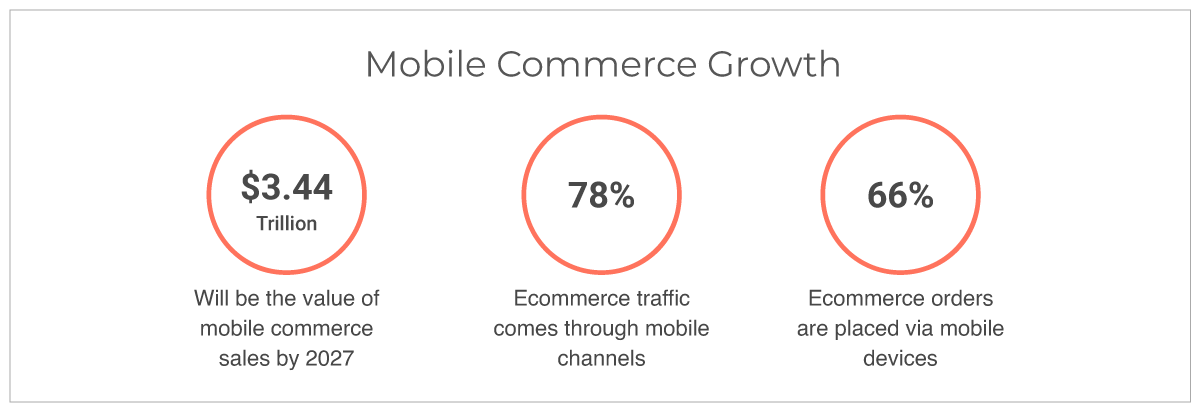
- $3.44 trillion will be the value of mobile commerce sales by 2027
- 78% of ecommerce traffic comes through mobile channels
- 66% of ecommerce orders are placed via mobile devices
Source: Statista
Whether you are targeting urban consumers through fashion apps or reaching rural audiences with hyperlocal delivery, a mobile commerce strategy can unlock entirely new market segments. Think of how Meesho has scaled its multi seller ecosystem by leaning heavily into mobile-first experiences.
StoreHippo helps you stay ahead with a platform that’s built from the ground up on mobile-first architecture. You can launch your multi vendor ecommerce website as a Progressive Web App (PWA) that works like a native app even on low-end devices. And with the built-in mobile app builder, you can roll out Android and iOS marketplace apps. StoreHippo also gives mobile apps for buyers, admins, vendors, and delivery agents without any third-party integrations.
Thanks to StoreHippo’s headless architecture, you can also reuse the same backend logic and APIs to create new mobile or digital touchpoints, like adding a “Buy Now” button on your blog or selling directly via your brand’s Instagram or WhatsApp channel. StoreHippo online marketplace builder comes with native solutions to help you leverage mobile-first, omnichannel commerce.
Pro Tip: Think beyond just apps extend your marketplace presence to where your customers already are, connect your social pages, blog pages and other touchpoints to your marketplace website.
7. Onboard Vendors and Get Products Listed
A multi vendor ecommerce website is only as strong as its seller ecosystem. Onboarding quality vendors and listing their products efficiently and helping them manage their business effortlessly is a critical step in building a thriving online marketplace. But for enterprise brands, this process needs to be fast, scalable, and structured, especially when dealing with thousands of sellers or multiple categories.
Look at IndiaMART, which hosts millions of product listings across industries, or Amazon, which supports diverse sellers with varying commission models. Efficient vendor onboarding and catalog management form the backbone of these platforms.
With StoreHippo, you get a comprehensive vendor management system that makes onboarding and cataloging seamless. Vendors can self-register, and use their dedicated dashboards to upload products in bulk using CSV files, and manage their catalogs, orders and fulfilment through intuitive dashboards. Admins can easily approve products, set vendor-specific commissions, and configure payouts all from a central panel.
What sets StoreHippo apart is its AI powered ecommerce cataloging tool, which helps standardise and categorise listings, improving discoverability and buyer experience. Whether you’re digitising dealer networks or scaling a niche seller portal, the platform ensures that your operations remain smooth and scalable from day one.
Pro Tip: Keep the onboarding process simple and transparent happy vendors are more likely to stay, promote, and grow alongside your marketplace. Reward your bestselling vendors with prominent positioning on your marketplace storefront. You can also offer paid positioning to your vendors as an additional revenue source on your multi seller portal.
8. Add Payment and Logistics to Power Seamless Fulfilment
Once your vendors and products are in place, the next step is to ensure your online marketplace can process payments and fulfill orders smoothly. For enterprise brands, integrating diverse payment gateways and logistics providers isn’t just about convenience, it’s key to delivering a frictionless buyer experience and earning long-term trust.
Think of platforms like Flipkart or FirstCry, their success hinges on fast deliveries and reliable, secure transactions across regions and buyer segments. The same applies when you build a marketplace website at enterprise scale.
StoreHippo simplifies this with 60+ pre-integrated payment solutions and support for domestic as well as international payment gateways, credit/debit cards, UPI, net banking, wallets, COD, and more. You also get access to 30+ logistics providers, with real-time shipping rates, bulk label generation, and order tracking, plus the flexibility to plug in your preferred service partners via APIs.
Whether you need location-based shipping rules, zone-wise delivery settings, or auto-split payments to vendors, StoreHippo offers built-in tools that make your multi vendor ecommerce website operations run like clockwork.
Pro Tip: Offering multiple trusted payment and delivery options builds buyer confidence and reduces cart abandonment, especially in a multi seller marketplace where buyer expectations are high.
9. Set Up Marketing and Promotion to Drive Growth
Building a marketplace is just the beginning, getting the right traffic and vendor visibility is what drives real growth. For enterprise brands, this means designing a marketing strategy that not only attracts buyers but also helps vendors succeed. In today’s competitive ecommerce environment, this process often begins before you even build a marketplace website.
Just like Nykaa wins customers with curated content and influencer partnerships, or Amazon dominates SEO with optimized listings and reviews, your online marketplace needs to leverage multiple marketing channels to stay visible and valuable.
StoreHippo gives you all the tools to get there, without needing extra plugins or third-party tools. You can:
- Build high-converting vendor stores or pages for each vendor
- Offer multi-level discounts, coupon campaigns, and personalized promotions
- Use strategies like bundling, upselling, and cross-selling
- Collect product and seller reviews to generate long-tail keyword content
- Run a full-featured blog to drive organic discovery
- Use built-in SEO tools to optimize every page
- Send automated push notifications, emails, and browser alerts to engage buyers and sellers
Everything is integrated and manageable from a single admin panel, saving time and improving consistency.
Pro Tip: Tailor your campaigns by buyer type, location, or seller group, and track results using StoreHippo’s inbuilt reports or integrations with tools like Google Analytics to fine-tune what works best.
10. Test Your Marketplace Site and Go Live
Before opening your doors to buyers and vendors, it's crucial to thoroughly test your multi vendor ecommerce website. For enterprise brands, where multiple stakeholders, workflows, and regions are involved, skipping this step can result in operational hiccups, poor buyer experience, or even vendor drop-offs.
Think of how platforms like Amazon or BigBasket maintain consistency during peak sales by rigorously testing everything from checkout flows to app responsiveness. Your online marketplace should be treated no differently, especially when aiming for a smooth, scalable launch.
StoreHippo’s battle tested solutions make it easy to go live in record time and finetune your flows based on your marketplace brand’s unique requirements. With built-in tax engine, GST invoices and bulk invoicing your operations aspects are further streamlined. You can do live orders, test region-specific delivery rules, validate tax calculations, and review end-to-end user journeys across desktop, PWA, and mobile apps.
With PCI-DSS and ISO-certified infrastructure, StoreHippo ensures your buyers and vendors have a secure, reliable platform from day one.
Pro Tip: Use your test phase to place live orders, onboard test vendors, and simulate real-time order processing across devices and locations it’ll give you the confidence to scale without last-minute surprises.
That’s it, with StoreHippo, you not only build a marketplace website in 10 easy steps but also give make your business an AI powered ecommerce platform.
Conclusion
As ecommerce continues to evolve, marketplaces are clearly emerging as the most effective model for scalable, personalised digital commerce. Whether you are building a B2B platform like IndiaMART, a service-led model like Urban Company, or a D2C marketplace portal like Nykaa, your success hinges on choosing a future-ready, AI powered ecommerce solution.
StoreHippo offers exactly that, a complete enterprise-grade platform built to help you launch, manage, and scale any kind of multi vendor ecommerce website. With built-in support for mobile commerce, AI-driven cataloging, seamless integrations, and customisable workflows, StoreHippo makes it easier to go live faster and grow smarter.
Ready to build your disruptive marketplace website and app? Start our 14-day free trial right away.
FAQs
1. Can I build a marketplace website quickly and cost-effectively in 2025 using StoreHippo?
Ans: Building a marketplace website in 2025 doesn’t have to be a long-drawn or resource-heavy process. With the right marketplace builder, you can reduce development time, skip third-party dependencies, and go to market faster.
StoreHippo offers an AI powered, fully hosted and managed, plug-and-play solution designed to help brands launch their multi vendor ecommerce website in record time. From ready-made vendor modules to drag-and-drop design tools and built-in marketing features, everything you need is available out of the box. This eliminates the need for expensive custom development or additional software purchases, making StoreHippo a cost-efficient and time-saving option for enterprises aiming to go live fast. Also, with its headless architecture and composable structure enterprises get the creative control and flexibility to created tailored marketplace solutions for their brand.
2. How does an AI powered ecommerce marketplace make a difference in 2025 and beyond?
Ans: With AI at its core, StoreHippo helps brands deliver smarter buyer journeys through personalised search, automated recommendations, and intelligent workflows. Also, built-in AI-powered cataloging tools simplify the tedious and error prone cataloging process by generating product descriptions through images.
In 2025 and beyond, StoreHippo’s AI powered ecommerce marketplace solutions empower enterprises to scale faster, optimise operations, and offer seamless, intuitive experiences across channels. This gives brands an edge and makes their business future-proof.
3. What makes StoreHippo the best choice for launching an AI powered ecommerce marketplace in 2025?
Ans: AI is transforming how buyers interact with online marketplaces, from smarter product recommendations to personalized shopping experiences. To stay relevant, your platform must be built with AI at its core, not as an add-on.
StoreHippo stands out as an AI-powered ecommerce platform that integrates intelligent search, automated workflows, and buyer behavior insights into the very fabric of the marketplace. Powered by headless architecture and open APIs, it enables businesses to deploy agentic AI capabilities, automate complex processes, and scale personalization effortlessly. This gives StoreHippo an edge over conventional platforms that lack native AI capabilities.
4. Is StoreHippo suitable for creating a scalable multi vendor ecommerce website for global markets?
Ans: Scalability is critical when your business plans include international expansion or multiple business verticals. A good multi seller platform should support growth without performance or customisation bottlenecks.
StoreHippo is built on a cloud-native, microservices-based architecture that allows brands to scale their online marketplace seamlessly across geographies. With multi-language, multi-currency, and location-based pricing support, StoreHippo helps you tailor your online marketplace for diverse markets. You also get marketing tools like discount engine, tax engine for streamlining country-specific taxes and integrations with global payment gateways and logistics providers to streamline payments and fulfilment. Whether you are selling across countries or managing multiple sub-stores under one brand, StoreHippo is designed to handle growth, both in volume and complexity.
5. How does StoreHippo build a marketplace website without coding or third-party plugins?
Ans: StoreHippo is designed as a complete marketplace solution with 300+ enterprise-grade features built natively into the platform. Unlike other popular ecommerce platforms that rely on external modules and plugins, StoreHippo offers ready-to-use tools for vendor management, payouts, logistics, product uploads, and more, right from the start. Its no-code environment and user-friendly admin panel make it easy to build and customise your AI-powered online marketplace without writing code or adding costly third-party plugins.
6. How does StoreHippo’s headless and mobile-first architecture give an edge to brands creating their online marketplace?
Ans: Today’s shoppers expect fast, seamless experiences across devices and channels. Traditional marketplace builders often struggle to keep up with these demands due to rigid, monolithic architecture or cumbersome plugin-based architecture.
StoreHippo is built on a pure headless architecture that separates the frontend from the backend, giving businesses the agility to create custom user experiences, experiment with multiple digital touchpoints and build a future-ready online marketplace for their brand. Coupled with its mobile-first architecture and inbuilt mobile apps builder, StoreHippo ensures that your online marketplace is available where your customers are. Whether accessed through a PWA store, mobile app, or marketplace website, your brand delivers a seamless, consistent, and high-performance shopping experience across all touchpoints. This architectural freedom is key to future-proofing your marketplace for evolving buyer behaviour.
7. Is it possible to integrate vendors’ logistics, payments, and ERP systems while building an online marketplace with StoreHippo?
Ans: Absolutely. Seamless backend integration is crucial for managing operations at scale and reducing manual effort in a growing a multi vendor marketplace.
StoreHippo comes with open 300+API endpoints that make it easy to integrate with a wide range of software solutions and service providers like ERP systems, logistics providers, payment gateways, and third-party marketing and analytics solutions.
Whether your vendors are using their own systems or you’re offering centralized ERP, shipping, or invoicing solutions, StoreHippo enables smooth, real-time data exchange, ensuring automated workflows, faster fulfilment, and unified control across your AI-powered ecommerce marketplace ecosystem.
8. Does StoreHippo support different business models like B2B, D2C, or hyperlocal ecommerce under a single marketplace website?
Ans: Yes, one of the biggest advantages of StoreHippo is its ability to accommodate diverse ecommerce models under one unified central control.
Whether your brand is running a B2B distributor powered marketplace, managing a D2C brand, or building a hyperlocal delivery marketplace, StoreHippo’s architecture is flexible enough to support each model or even combinations of them. With features like audience-specific pricing, MOQ, location-based stores, and custom checkout flows, you can tailor your multi vendor ecommerce website to suit your business logic, and create multiple marketplace models, under same central admin, without replatforming.



